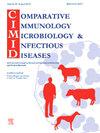Occurrence of pathogenic and antimicrobial-resistant bacteria in feces of wild mammals from a National Park in Central Italy
IF 2
3区 农林科学
Q4 IMMUNOLOGY
Comparative Immunology Microbiology and Infectious Diseases
Pub Date : 2025-06-26
DOI:10.1016/j.cimid.2025.102372
引用次数: 0
Abstract
Wild animals can act as reservoirs and spreader for various pathogens, contributing to the environmental contamination. Additionally, wildlife is an important bioindicator of its habitats. This study aimed to investigate the presence of specific bacterial zoonotic pathogens and antimicrobial resistant bacteria in feces of wild mammals. A total of 124 fecal samples were collected from a National park in Central Italy and tested for the presence of Salmonella spp., Yersinia enterocolitica, Listeria monocytogenes, Coxiella burnetii, Mycobacterium spp., Extended Spectrum β-Lactamase (ESBL) and carbapenemase producing Enterobacteriaceae. Salmonella enterica serotype Agama was isolated from the feces of five badgers and one roe deer, displaying the same pulsotype, while Salmonella enterica serotype Eboko was identified in a single fecal sample from a mustelid. Y. enterocolitica was detected in 30 of the fecal samples from various species; Two isolates were classified as biotype 4, seven as biotype 3, and 21 as biotype 1 A, with all exhibiting different pulsotypes. Most isolates of Salmonella and Yersinia demonstrated full susceptibility to the antimicrobials tested. One ESBL producing Escherichia coli was detected in the feces of a mustelid, testing positive for the blaTEM-1 and blaCTX-M-15 genes. L. monocytogenes, C. burnetii, Mycobacterium spp., and cephalosporinase producing Enterobacteriaceae were not detected. These findings underscore the role of wild mammals as potential spreaders of zoonotic pathogens and antimicrobial resistant bacteria, despite the relatively low detection rates. Ongoing monitoring programs in wildlife are essential to know the microorganisms circulation in specific areas and to assess the risks they pose to public health.
意大利中部国家公园野生哺乳动物粪便中致病性和耐药细菌的发生
野生动物可以作为各种病原体的宿主和传播者,造成环境污染。此外,野生动物是其栖息地的重要生物指标。本研究旨在调查野生哺乳动物粪便中特异性细菌人畜共患病原体和耐药细菌的存在情况。从意大利中部的一个国家公园收集了124份粪便样本,检测了沙门氏菌、小肠结肠炎耶尔森菌、单核细胞增生性李斯特菌、伯纳氏杆菌、分枝杆菌、广谱β-内酰胺酶(ESBL)和产碳青霉烯酶的肠杆菌科细菌的存在。从5只獾和1只狍的粪便中分离到肠道沙门氏菌血清型Agama,显示出相同的脉型,而从1只鼬的粪便样本中分离到肠道沙门氏菌血清型Eboko。在30份不同种类的粪便样本中检出小肠结肠炎耶氏菌;2个分离株为生物型4,7个为生物型3,21个为生物型1 A,所有分离株均表现出不同的脉冲型。大多数分离的沙门氏菌和耶尔森菌对所测试的抗菌素完全敏感。在mustelid粪便中检测到一种产生ESBL的大肠杆菌,blatem1和blaCTX-M-15基因检测呈阳性。未检出单增李斯特菌、伯氏杆菌、分枝杆菌和产头孢菌素的肠杆菌科细菌。这些发现强调了野生哺乳动物作为人畜共患病原体和耐药细菌的潜在传播者的作用,尽管其检出率相对较低。野生动物的持续监测项目对于了解特定地区的微生物循环和评估它们对公众健康构成的风险至关重要。
本文章由计算机程序翻译,如有差异,请以英文原文为准。
求助全文
约1分钟内获得全文
求助全文
来源期刊
CiteScore
4.60
自引率
0.00%
发文量
102
审稿时长
40 days
期刊介绍:
Comparative Immunology, Microbiology & Infectious Diseases aims to respond to the concept of "One Medicine" and to provide a venue for scientific exchange. Based on the concept of "Comparative Medicine" interdisciplinary cooperation between specialists in human and animal medicine is of mutual interest and benefit. Therefore, there is need to combine the respective interest of physicians, veterinarians and other health professionals for comparative studies relevant to either human or animal medicine .
The journal is open to subjects of common interest related to the immunology, immunopathology, microbiology, parasitology and epidemiology of human and animal infectious diseases, especially zoonotic infections, and animal models of human infectious diseases. The role of environmental factors in disease emergence is emphasized. CIMID is mainly focusing on applied veterinary and human medicine rather than on fundamental experimental research.

 求助内容:
求助内容: 应助结果提醒方式:
应助结果提醒方式:


